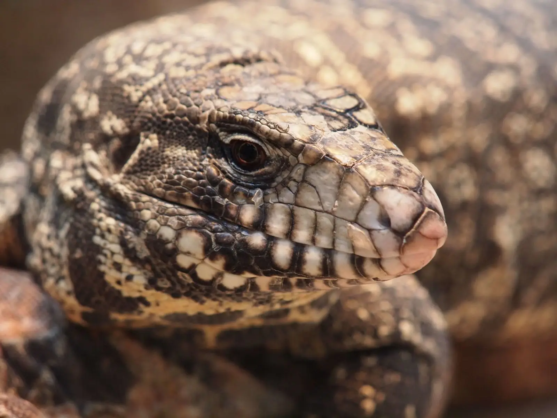Black & White Tegu
Reptilarium Animals
Argentine Black and White Tegu
Conservation status (Least Concern)


The Argentine black and white tegu (Salvator merianae ), also known as the Argentine giant tegu, the black and white tegu, the huge tegu, and the lagarto overo in Spanish, is a species of lizard in the family Teiidae. The species is the largest of the "tegu lizards". It is an omnivorous species which inhabits the tropical rain forests, savannas and semi-deserts of eastern and central South America.
Tegus are sometimes kept as pets by humans. They are notable for their unusually high intelligence and can also be housebroken. Like other reptiles, tegus go into brumation in autumn when the temperature drops. They exhibit a high level of activity during their wakeful period of the year. They are the only known reptiles to be partly endothermic.
Tegus fill ecological niches similar to those of monitor lizards, but are only distantly related to them; the similarities are an example of convergent evolution.


The Argentine black and white tegu is a large lizard native to South America. These lizards are popular as pets because they have unusually high intelligence and can also be house-broken. As hatchlings, these tegus have an emerald green colour from the tip of their snout to midway down their neck with black markings. The emerald green becomes black several months after shedding. As a young tegu, the tail is banded yellow and black; as it ages, the solid yellow bands nearest the body change to areas of weak speckling. Fewer solid bands indicate an older animal. A tegu can drop a section of its tail as a distraction if attacked. The tail is also used as a weapon to swipe at an aggressor; even a half-hearted swipe can leave a bruise. The females are usually much smaller than males. They have beaded skin and stripes running down their bodies.
Argentine black and white tegus are generally solitary and diurnal reptiles. They are terrestrial but young tegus are more arboreal and often spend the time in trees to stay safe from predators. Tegus usually spend their time basking in the sun to regulate their body temperature and foraging. During the winter months, they brumate (hibernation-like state), usually in groups. Tegus are capable of running at high speeds and can run bi-pedally for short distances. They often use this method in territorial defence, with the mouth open and front legs held wide to look more threatening. Tegus make good pets, as they tend to become acclimated to their owners and are generally quite docile as adults. They are intelligent and can even be house-broken. However, if they are not handled regularly, they show more aggressive behaviour; their bite can be painful and damaging due to strong jaws and sharp teeth. Tegus do not produce venom. They will perform a threat display if they are upset or stressed. The first stage is huffing, or very heavy breathing, which means be careful. Then the animal starts lashing its tail, somewhat like a moving snake. In wild, after that tegus may stamp their front feet, this performance is also known as a "dance". If these hints are ignored, then the tegu can charge and may bite.


Argentine black and white tegus are omnivorous. Juveniles in the wild consume a wide range of invertebrates, including insects, spiders, and snails. They also eat fruits and seeds. As they grow they become more predatory. They may seek out eggs from other reptiles and from birds' nests and will eat small birds, vertebrates, insects and wild fruits.

